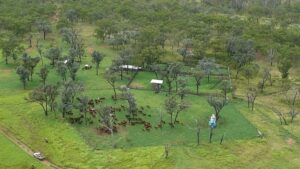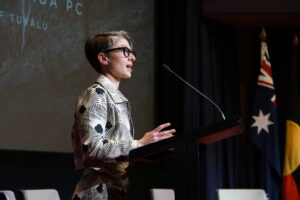Can carbon offsets save the environment?

If you’ve ever ticked ‘yes’ to offsetting your carbon emissions when you booked a flight, it might have felt like you were doing something good. Planting some more trees to make up for your trip certainly offsets our guilt. But does it actually take carbon out of the atmosphere?
At a larger scale, the Government is leaning into offsetting and market-based schemes for tackling climate change and biodiversity decline through its safeguard mechanism and nature repair market. The Government even has its own carbon neutral certification scheme that gives a green tick to businesses that buy offsets, like that airline you booked your flight through.
A Brief History of Carbon Offsets and Carbon Trading
The concept of carbon offsetting arose in the late 1980s after an energy company funded tree planting to offset the impact of its coal-fired power station.
The idea eventually evolved into a mainstream concept, with the establishment of fully-fledged ‘carbon markets’. In the late 1990s a global carbon market called the Clean Development Mechanism was created under the Kyoto Protocol, an international climate agreement. While not the original intent of the market, in practice the CDM meant rich countries like Australia could buy carbon offsets generated by projects in developing countries so that they could meet our climate targets, without altering the production of fossil fuels.
Over the years there has been a proliferation of offset or emissions trading schemes around the world. The most well-known one being the European Union’s (EU) Emissions Trading Scheme.
Australia also had what was going to be an ETS in 2012. When the carbon price was repealed it just became an unlimited offset scheme. The government bought most of the offsets and big polluters were required to buy them when they exceeded pollution limits set by the government.
Carbon offsetting used to play a small role in Australia’s climate policy. However, over the last few years it has become front and centre and it’s putting the chances of Australia being able to meet its climate targets at risk.
Do Carbon Markets Work?
There have been lots of studies about the types of carbon pricing, offset, and emissions trading schemes that exist globally, but very few that assess how successful they’ve been in actually reducing emissions.
To get a big picture indication of how successful they’ve been, you only need to consider that just over half of all cumulative global greenhouse gas emissions have taken place in the last 30 years, which, coincidentally, is when carbon trading as an idea took hold. If carbon markets were working to reduce emissions you’d think that maybe emissions would be dropping. They’re not.
Critically, carbon trading schemes aren’t designed to reduce emissions at a system level. For big emitters that are buying offsets without changing their business model, the best-case scenario is the maintenance of the emissions status quo. Worst case scenario (ie the offsets are junk or they’re only being used to offset a small amount of an entity’s emissions), emissions increase.
How are Carbon Offset Markets Regulated?
Unfortunately, there is little evidence to indicate that carbon markets or carbon offset schemes are being regulated in any meaningful way. A number of studies and media investigations (see Verra forest credits for an example) have suggested that regulation in both regulated and voluntary carbon markets is either poor or completely absent.
A recent Four Corners story revealed logging occurring in forests in PNG that were supposedly being protected as part of a carbon offset project. It also raised legal questions around the benefit sharing and treatment of customary landowners. Australian businesses were buying these credits and claiming to be carbon neutral however no one on the ground in PNG or in Australia was checking whether the credits or claims made by these businesses were legitimate.
In Australia, we nominally have ‘one of the most robust and heavily regulated carbon offset schemes in the world’. But a large body of independent research by academics and the Australia Institute has provided significant evidence that Australia’s carbon offsets are just hot air.
Flaws in the System
A recent independent government review of Australia’s carbon offsets gave the whole system a tick of approval. However, the review panel didn’t assess a single piece of satellite imagery or project data. So, while Australia’s offsets appear to be regulated on paper, there are no independent parties actually checking and measuring to ensure the offsets are credible.
The government doesn’t release the data that would allow independent scrutiny of offset projects. The carbon stored or avoided by offset projects is predominantly calculated by modelling – there is no dedicated body out there measuring how trees are growing or measuring soil and changes in habitat. If data on the ground isn’t being routinely, robustly and independently considered, how can Australians know carbon offsets are offsetting anything at all?
When the carbon offsets are junk but used to justify business as usual – or even worse – to justify opening a new gas or coal mine, then of course the result is an increase in emissions.
For more, listen to Polly Hemming on ABC’s RN.
Between the Lines Newsletter
The biggest stories and the best analysis from the team at the Australia Institute, delivered to your inbox every fortnight.
You might also like
Here are 23 Times Carbon Offsets Were Found to be Dodgy
Carbon offsetting has received a lot of attention recently. As businesses and governments look to meet their climate targets, many are turning to carbon offsets. That is, they are paying someone else to reduce or avoid putting greenhouse gases into the atmosphere, so they don’t have to.
The Climate Crisis is an Integrity Crisis | Polly Hemming
I am starting my address to this year’s summit in the exact same way that I started last year’s address. Because it is just over a year since I delivered these same words, which aren’t actually my words. They are the words of our Climate Change Minister, and they provide a baseline of sorts for what progress has been made in that time.
The carbon con killing koalas
The NSW Labor Government took office promising to create a vast koala sanctuary on the state’s mid-north coast – the Great Koala National Park. Despite the threat of koala extinction in the state, more than a year later the Great Koala National Park is yet to be established.



